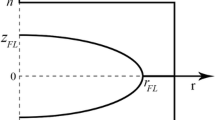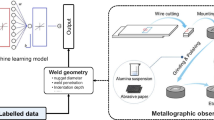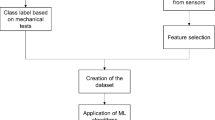Abstract
Much work has been done in the area of modelling resistance spot welding. Most of this work predicts the weld geometry resulting from particular process parameters. This is well known and can be easily predicted using low-cost tools. Predicting post-weld properties is much more difficult though. Most of this work needs large computing power and complex modelling techniques such as neural networks. This is made more complex when welds exhibit heat-affected zone softening. This study proposes a simple three-step method to model the hardness profile of resistance spot welds. First, the temperature history throughout the weld zone is calculated. Second, known models describing the local phase transformations that occur during welding are applied. Finally, the results across the weld are assembled into the hardness profile prediction. The validity range of this model is wide in terms of martensite chemical content, sheet thickness and process parameters. Predictions were validated against welds in three martensitic steels with varying amounts of carbon and alloying additions.









Similar content being viewed by others
References
Hamidinejad SM, Kolahan F, Kokabi AH (2012) The modeling and process analysis of resistance spot welding on galvanized steel sheets used in car body manufacturing. Mater Des 34:759–767
Biro E and Dupuy T (2008) Effect of steel processing chemistry variation on resistance spot welding, The 5th International Seminar on Advances in Resistance Welding, Toronto, Canada, pp. 66–77
Baltazar Hernandez VH, Panda SK, Okita Y, Zhou Y (2010) A study on heat affected zone softening in resistance spot welded dual phase steel by nanoindentation. J Mater Sci 45:1638–1647
Baltazar Hernandez VH, Kuntz ML, Khan MI, Zhou Y (2008) Influence of microstructure and weld size on the mechanical behaviour of dissimilar AHSS resistance spot welds. Sci Technol Weld Join 13(8):769–776
Yu L, Nakabayashi Y, Sasa M, Itoh S, Kameyama M, Hirano S, Chigusa N, Saida K, Mochizuki M, Nishimoto K (2011) Neural network prediction of hardness in HAZ of temper bead welding using the proposed thermal cycle tempering parameter (TCTP). ISIJ Int 51(9):1506–1515
Ion JC, Easterling KE, Ashby MF (1984) A second report on diagrams of microstructure and hardness for heat-affected zones in welds. Acta Metall 32(11):1949–1962
Xia M, Biro E, Tian Z, Zhou Y (2008) Effects of heat input and martensite on HAZ softening in laser welding of dual phase steels. ISIJ Int 48(6):809–814
Biro E, McDermid JR, Embury JD, Zhou Y (2010) Softening kinetics in the subcritical heat-affected zone of dual-phase steel welds. Metall Mater Trans A 41A(9):2348–2356
Marya M, Gayden XQ (2005) Development of requirements for resistance spot welding dual-phase (DP600) steels—Part 2: Statistical analyses and process map. Weld J 84(12):197s–204s
Vignier S, Biro E, Hervé M and Bouaziz O (2012) Martensite short time tempering kinetics parameters and applications to HAZ softening in laser and spot welding, ArcelorMittal Internal Report, Report no. 2012 16725 RDMA
Yurioka Y, Okumura M, Kasuya T, Cotton HJU (1987) Prediction of HAZ hardness of transformable steels. Met Constr Br Weld 19(4):217R–223R
Lucas E and Karkor I (2009) Spot welding: building the link between chemistry, microstructure and mechanical properties for high strength steels, ArcelorMittal Internal Report, no. 2009 11657 AUP
Shi J, Liu CR (2005) On predicting softening effects in hard turned surfaces—Part I: Construction of material softening model. J Manuf Sci E-T ASME 127(3):476–483
Mittemeijer EJ, Cheng L, van der Schaff PJ, Brakman CM, Korevaar BM (1988) Analysis of nonisothermal transformation kinetic tempering of iron-carbon and iron-nitrogen martensites. Metall Trans A 19A(4):925–932
Takahashi M, Bhadeshia HKDH (1990) Model for transition from upper to lower bainite. J Mater Sci Technol 6(7):592–603
Cheng L, Brakman CM, Korevaar BM, Mittemeijer EJ (1988) The tempering of iron-carbon martensite; dilatometric and calorimetric analysis. Metall Trans A 19A(10):2415–2426
Speich GR (1969) Tempering of low-carbon martensite. Trans Met Soc AIME 245(12):2553–2564
Biro, E., Vignier, S., Kaczynski, C., McDermid, J.R., Lucas, E., Zhou, Y. and Embury, J.D.: Predicting transient softening in the sub-critical heat-affected zone of dual-phase and martensitic steel welds, Submitted to ISIJ Int
ASM Handbook, Volume 1, Properties and Selection: Irons, Steels, and High Performance Alloys, ASM International, Materials Park, OH, 1990
Li SJ, Ishihara M, Yumoto H, Aizawa T, Shimotomai M (1998) Characterization of cementite films prepared by electron-shower-assisted PVD method. Thin Solid Films 316(1):100–104
Andrews KW (1965) Empirical formulae for the calculation of some transformation temperatures. J Iron Steel Inst 203(7):721–727
Pavlina EJ, Van Tyne CJ (2008) Correlation of yield strength and tensile strength with hardness for steels. J Mater Eng Perform 17(6):888–893
Acknowledgments
The authors would like to thank Thomas Dupuy, who carried out the Sorpas simulations to validate the use of the Rosenthal equation to predict temperature history and Olivier Bouaziz, who offered advice to better apply the JMAK equation to the problem of HAZ softening. Furthermore, we would like to thank ArcelorMittal for allowing this work to be published.
Author information
Authors and Affiliations
Corresponding author
Additional information
Doc. IIW-2431, recommended for publication by SC-Auto "Select Committee Automotive and Road Transport."
Rights and permissions
About this article
Cite this article
Vignier, S., Biro, E. & Hervé, M. Predicting the hardness profile across resistance spot welds in martensitic steels. Weld World 58, 297–305 (2014). https://doi.org/10.1007/s40194-014-0116-0
Received:
Accepted:
Published:
Issue Date:
DOI: https://doi.org/10.1007/s40194-014-0116-0




